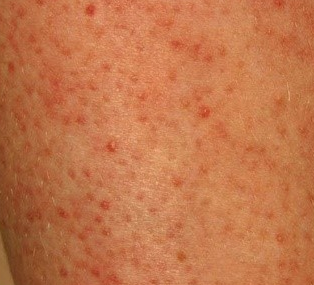

Petechiae are formed when capillaries (small blood vessels) bleed and leak blood into the skin. Petechiae can occur anywhere on the body, but some of the most common areas in which petechiae occur are: Will turn pale or lighter in color when touched Here are some of the main differences between petechiae and skin rashes: Presentation They are dots that form under the skin or mucous membranes caused by broken blood vessels. Skin Rashīecause petechiae can appear in clusters, they are often confused for a skin rash, but petechiae are not rashes. Unlike other skin conditions, they are not raised or bumpy and do not lose color when you press or touch them. They can be red, brown, or purple in color. Petechiae are very small and measure less than 2 mm in size. They are the result of bleeding which can be caused by several factors including injury, infection, and noninfectious medical conditions. Petechiae are pinpoint-sized spots that appear under the skin or mucous membranes. We’ll also cover the most common places petechiae occur and what can cause them.įinally, we’ll explain what you can do to prevent them and when to reach out to a healthcare provider for diagnosis and treatment.
#Pinpoint red dots on skin turn brown platelets how to
In this article, we’ll go over what petechiae are and how to distinguish them from a skin rash. Though petechiae are common, they can have several different causes, some of which can be serious. Petechiae are small, round dots of bleeding that form under the skin or mucous membranes. This option is also great because there are very few chances of scarring.Discovering unfamiliar spots on your skin or your child’s skin can be concerning, which is why it’s important to know the difference between a skin rash and petechiae. Your skin will automatically heal, and you won’t be needing any extra care for it. This procedure is best for small moles, and there is no need for stitches or any sutures. Shave Excision is a small invasive procedure in which a small cut is made on the skin to remove the red moles. This is also an easy and quick procedure but you may need two to three sessions depending on the quantity and size of your moles. The laser emits heat to burn and remove the mole. In this treatment, pulsed dye laser (PDL) is used to eliminate the red moles on the skin.

The aftercare of this surgery is very simple, and nothing extraordinary needs to be done to care for the skin. This procedure is relatively quick and typically only requires one sitting to remove the red moles completely. Liquid nitrogen is sprayed on the moles for at least 10 seconds, and the extreme coldness from the liquid nitrogen will freeze the moles, causing them to scab over and eventually fall off. This is a safe procedure, and this technique’s recovery time is also very quick.Ĭryosurgery uses liquid nitrogen to remove red moles. In this treatment, the red moles are burned using an electric current which is passed through a tiny probe. The first procedure used for the removal of cherry angioma is electrocauterization. Cherry Angioma are benign (non cancerous), although some people may wish to remove these moles for cosmetic purposes.įollowing are the techniques and methods that are most commonly used the removal of red moles:


 0 kommentar(er)
0 kommentar(er)
